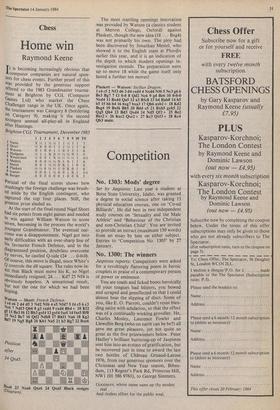Chess
Home win
Raymond Keene
It is becoming increasingly obvious that computer companies are natural spon- sors for chess events. Further proof of this was provided by the generous support offered to the 1983 Grandmaster tourna- ment at Brighton by CGL (Computer Games Ltd) who market the Chess Challenger range in the UK. Once again, the tournament was Category 8 (bordering °1-1 Category 9), making it the second strongest annual all-play-all in England after Hastings.
Brighton CGL Tournament, December 1983
1 2 3 4 5 6 7 8 9 10 III 1 Nunn X1/211/21/21 11/211 7 2 Short 1/2 X 0 0 I 1 1 1/2 1 1 6 3 Watson 0 I X 0 I 1 0 1 1 1 6
4 Hodgson Y2 1 1 X 0 1/2 1/2 1/2 0 I
5 S Westerinen
Y2 0 0 1 X 1/2 1/2 1/2 1/2 1
41/2
6 Mednis 0 0 0 1/2 1/2 X 1 0 1 1
4
7 Murei
0 0 I 1/2 1/2 0 X 1 I 0 4
8 Plaskett 1/2 1/2 0 1/2 1/2 1 0 X 0 1
4 9 Ivanov 00011/200IXI 31/2
10 Burger
000000100X
Perusal of the final scores shows how crushingly the foreign challenge was brush- ed aside by the English contingent, who captured the top four places. Still, the greatest prize eluded us.
At the start of the final round Nigel Short had six points from eight games and needed to win against William Watson to score seven, becoming in the process the world's Youngest Grandmaster. The eventual out- come was a disappointment. Nigel got into early difficulties with an over-sharp line of his favourite French Defence, and in the diagrammed position, doubtless overcome by nerves, he castled Q-side (24 ... 0-0-0).
0f course, this move is illegal, since White's Q controls the d8 square. The rules now in- sist that Black must move his K, so Nigel untnediately resigned; 24 ... Kd7 25 Nf4 is obviously hopeless. A sensational result,
but not the one for which we had been hoping.
Watson — Short: French Defence.
1 e4 e6 2 d4 d5 3 Nd2 Nf6 4 e5 Nfd7 5 f4 c5 6 c3 NO 7 Ndf3 Qb6 8 g3 cxd4 9 cxd4 Bb4 + 10 Kf2 gS 11 Be3 f6 12 Bh3 gxf4 13 gxf4 fxe5 14 fxe5 Rf8 IS Ne2 Be7 16 Qd2 Ndb8 17 Rhfl Na6 18 Kg2 HO 19 Ng5 Rg8 20 Khl Nay 21 b3 Rg7 22 Bxe6
Position after 24 coxas.
Bxe6 23 Nxe6 Qxe6 24 QxaS Black resigns (Diagram).
The most startling openings innovation was provided by Watson (a classics student at Merton College, Oxford) against Plaskett, though the new idea (18 ... Bxg4) was not primarily his own. The ploy had been discovered by Jonathan Mestel, who showed it to the English team at Plovdiv earlier this year, and it is an indication of the depth to which modern openings in- vestigation extends. The preparation went up to move 18 while the game itself only lasted a further ten moves?
Plaskett — Watson: Sicilian Dragon.
1 e4 c5 2 Nf3 d6 3 d4 cxd4 4 Nxd4 Nf6 5 Nc3 g6 6 Be3 Bg7 7 f3 0-0 8 Qd2 Nc6 9 g4 Be6 10 0-0-0 Nxd4 11 Bxd4 Qa5 12 a3 Rfc8 13 h4 Rab8 14 h5 b5 15 h6 b4 16 hxg7 bxa3 17 Qh6 axb2 + 18 Kd2 Bxg4 19 Bxf6 Bh5 20 Bd4 e5 21 Rxh5 gxh5 22 Qg5 Qb4 23 BO Qxd4 24 Nd5 Of2 + 25 Bet Fbcc2 + 26 Kxc2 Qxe2 + 27 Kc3 Qxf3 + 28 Kc4 Qb3 mate.






































 Previous page
Previous page